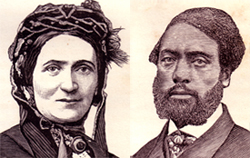
Throughout the near 250 year history of slavery in the Americas, countless numbers of chattel slaves devised brilliant means of escape in a number of different ways. Some bought their way out. One man, Henry "Box" Brown, even mailed himself to Philadelphia in a wooden crate. Perhaps it was William and Ellen Craft who pulled off one of the most creative forms of escape known of in historical memory. The lightly complexioned Ellen dressed as a man and portrayed herself as her husband’s master, journeying their way to Philadelphia in 1848 and later to Great Britain.
In a number of instances of this tale, one notices the evolution of the Crafts in both their character and their daring exploits. The Crafts not only learn more about the state of affairs in America at their time, but they also are prompt to use their wits and depend on each other to achieve their common goal of freedom. Initially, the two slaves show hesitancy and pessimism in their prospects of escape. Nevertheless, the Crafts' outlook on this situation soon changes. They noted, “[A]fter puzzling our brains for years, we were reluctantly driven to the sad conclusion, that it was almost impossible to escape from slavery in Georgia, and travel 1,000 miles across the slave States....but at the same time ever to keep our dim eyes steadily fixed upon the glimmering hope of liberty, and earnestly pray God mercifully to assist us to escape from our unjust thralldom.”
Gone were the meek and subjected slaves from Macon, Georgia. The Crafts transformed themselves into audacious and equally enterprising individuals, thirsty for freedom and the opportunity to make their way in the world. As many African-Americans felt at this time, the chance of freedom was an extraordinary opportunity to become ordinary. Perhaps others noticed their undaunted bravery more than the Crafts themselves. In the January 4, 1849 edition of The Liberator, abolitionist William Wells Brown said this of the exploits of William and Ellen Craft: “Their history, especially that of their escape, is replete with interest. They will be at the meeting of the Massachusetts Anti-Slavery Society, in Boston, in the latter part of this month, where I know the history of their escape will be listened to with great interest. They are very intelligent. They are young, Ellen 22, and Wm. 24 years of age. Ellen is truly a heroine.”
A significant portion of the Craft’s book, Running a Thousand Miles for Freedom: Or The Escape of William and Ellen Craft from Slavery, discusses the immediate horrors of slavery even more so than their direct escape. This function serves a very distinct purpose in the storyline. Through such vivid descriptions of oppression, many 19th Century readers would come to the full realization of the horrors of slavery and why one would wish to escape its chains. In one excerpt, Craft described one particularly cruel trait of the peculiar institution: “I have myself conversed with several slaves who told me that their parents were white and free; but that they were stolen away from them and sold when quite young. As they could not tell their address, and also as the parents did not know what had become of their lost and dear little ones, of course all traces of each other were gone.” Such was a common story amongst slave families throughout the Antebellum South.
To add insult to injury, many slave auctioneers would not even allow loved ones to bid each other farewell at their sale. One such instance we gruesomely retold by Craft: “My poor sister was sold first: she was knocked down to a planter who resided at some distance in the country....I at once asked a slave friend who was standing near the platform, to run and ask the gentleman if he would please to wait till I was sold, in order that I might have an opportunity of bidding her good-bye. He sent me word back that he had some distance to go and could not wait....I then turned to the auctioneer, fell upon my knees, and humbly prayed him to let me just step down and bid my last sister farewell. But, instead of granting me this request, he grasped me by the neck, and in a commanding tone of voice, and with a violent oath, exclaimed, ‘Get up! You can do the wench no good; therefore there is no use in your seeing her.’” Could not such stories transform the objective Victorian reader into a staunch abolitionist? Yes, and it did. Because of such engaging and compelling traits in addition to the pure emotion displayed throughout, the Crafts' story has become one of the most widely read and appreciate slave narratives since it's publishing in 1860. The greater question, however, is what can we achieve by reconnecting to their enduring tale?

Ellen and William Craft.

No comments:
Post a Comment